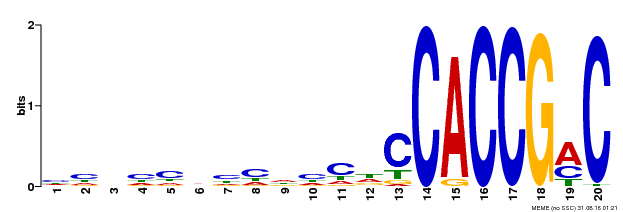| Signature Domain? help Back to Top |
 |
| No. |
Domain |
Score |
E-value |
Start |
End |
HMM Start |
HMM End |
| 1 | AP2 | 56.6 | 6.6e-18 | 48 | 98 | 1 | 55 |
AP2 1 sgykGVrwdkkrgrWvAeIrdpsengkrkrfslgkfgtaeeAakaaiaarkkleg 55
++ykGVr ++ +g+Wv+eIr p ++++r++lg++ tae Aa+a++ a ++l+g
AT1G21910.1 48 KKYKGVRMRS-WGSWVSEIRAP---NQKTRIWLGSYSTAEAAARAYDVALLCLKG 98
59*****998.**********9...336************************998 PP
|
| Publications
? help Back to Top |
- Riechmann JL, et al.
Arabidopsis transcription factors: genome-wide comparative analysis among eukaryotes.
Science, 2000. 290(5499): p. 2105-10
[PMID:11118137] - Dal Bosco C, et al.
Inactivation of the chloroplast ATP synthase gamma subunit results in high non-photochemical fluorescence quenching and altered nuclear gene expression in Arabidopsis thaliana.
J. Biol. Chem., 2004. 279(2): p. 1060-9
[PMID:14576160] - Rizhsky L,Davletova S,Liang H,Mittler R
The zinc finger protein Zat12 is required for cytosolic ascorbate peroxidase 1 expression during oxidative stress in Arabidopsis.
J. Biol. Chem., 2004. 279(12): p. 11736-43
[PMID:14722088] - Guan Y,Nothnagel EA
Binding of arabinogalactan proteins by Yariv phenylglycoside triggers wound-like responses in Arabidopsis cell cultures.
Plant Physiol., 2004. 135(3): p. 1346-66
[PMID:15235117] - Wang R, et al.
Genomic analysis of the nitrate response using a nitrate reductase-null mutant of Arabidopsis.
Plant Physiol., 2004. 136(1): p. 2512-22
[PMID:15333754] - Hilson P, et al.
Versatile gene-specific sequence tags for Arabidopsis functional genomics: transcript profiling and reverse genetics applications.
Genome Res., 2004. 14(10B): p. 2176-89
[PMID:15489341] - Lee D,Polisensky DH,Braam J
Genome-wide identification of touch- and darkness-regulated Arabidopsis genes: a focus on calmodulin-like and XTH genes.
New Phytol., 2005. 165(2): p. 429-44
[PMID:15720654] - Suzuki N, et al.
Enhanced tolerance to environmental stress in transgenic plants expressing the transcriptional coactivator multiprotein bridging factor 1c.
Plant Physiol., 2005. 139(3): p. 1313-22
[PMID:16244138] - Nakano T,Suzuki K,Fujimura T,Shinshi H
Genome-wide analysis of the ERF gene family in Arabidopsis and rice.
Plant Physiol., 2006. 140(2): p. 411-32
[PMID:16407444] - Wagner R,Pfannschmidt T
Eukaryotic transcription factors in plastids--Bioinformatic assessment and implications for the evolution of gene expression machineries in plants.
Gene, 2006. 381: p. 62-70
[PMID:16934950] - Lee J, et al.
Analysis of transcription factor HY5 genomic binding sites revealed its hierarchical role in light regulation of development.
Plant Cell, 2007. 19(3): p. 731-49
[PMID:17337630] - Sottosanto JB,Saranga Y,Blumwald E
Impact of AtNHX1, a vacuolar Na+/H+ antiporter, upon gene expression during short- and long-term salt stress in Arabidopsis thaliana.
BMC Plant Biol., 2007. 7: p. 18
[PMID:17411438] - Kleine T,Kindgren P,Benedict C,Hendrickson L,Strand A
Genome-wide gene expression analysis reveals a critical role for CRYPTOCHROME1 in the response of Arabidopsis to high irradiance.
Plant Physiol., 2007. 144(3): p. 1391-406
[PMID:17478635] - Ramel F, et al.
Genome-wide interacting effects of sucrose and herbicide-mediated stress in Arabidopsis thaliana: novel insights into atrazine toxicity and sucrose-induced tolerance.
BMC Genomics, 2007. 8: p. 450
[PMID:18053238] - Ferreira FJ,Guo C,Coleman JR
Reduction of plastid-localized carbonic anhydrase activity results in reduced Arabidopsis seedling survivorship.
Plant Physiol., 2008. 147(2): p. 585-94
[PMID:18434607] - Krishnaswamy SS, et al.
Transcriptional profiling of pea ABR17 mediated changes in gene expression in Arabidopsis thaliana.
BMC Plant Biol., 2008. 8: p. 91
[PMID:18783601] - Krishnaswamy S,Verma S,Rahman MH,Kav NN
Functional characterization of four APETALA2-family genes (RAP2.6, RAP2.6L, DREB19 and DREB26) in Arabidopsis.
Plant Mol. Biol., 2011. 75(1-2): p. 107-27
[PMID:21069430] - Gaudinier A, et al.
Enhanced Y1H assays for Arabidopsis.
Nat. Methods, 2011. 8(12): p. 1053-5
[PMID:22037706] - Kazama D,Kurusu T,Mitsuda N,Ohme-Takagi M,Tada Y
Involvement of elevated proline accumulation in enhanced osmotic stress tolerance in Arabidopsis conferred by chimeric repressor gene silencing technology.
Plant Signal Behav, 2014. 9(3): p. e28211
[PMID:24614501] - Kazama D, et al.
Identification of Chimeric Repressors that Confer Salt and Osmotic Stress Tolerance in Arabidopsis.
Plants (Basel), 2013. 2(4): p. 769-85
[PMID:27137403]
|





